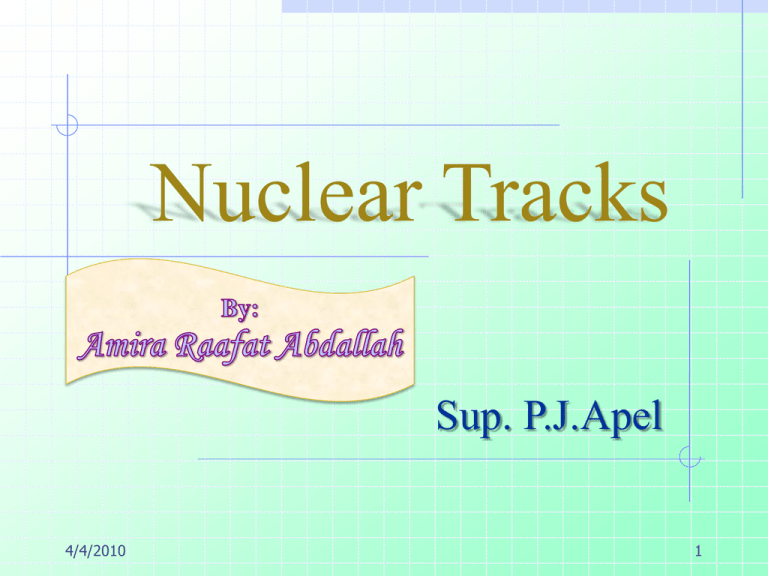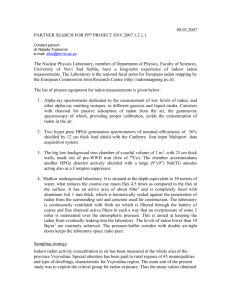Nuclear Tracks
advertisement

Nuclear Tracks Sup. P.J.Apel 4/4/2010 1 Solid-state nuclear track detector A solid-state nuclear track detector or SSNTD (also known as an etched track detector or a dielectric track detector, DTD) is a sample of a solid material (photographic emulsion, crystal, glass or plastic) exposed to nuclear radiation (neutrons or charged particles, occasionally also gamma rays), etched, and examined microscopically. The tracks of nuclear particles are etched faster than the bulk material, and the size and shape of these tracks yield information about the mass, charge, energy and direction of motion of the particles. If the particles enter the surface at normal incidence, the pits are circular; otherwise the ellipticity and orientation of the elliptical pit mouth indicate the direction of incidence. 4/4/2010 2 Charged particles which penetrate a solid, can lose their energy via various interaction types, such as • Excitation and ionization of target electrons (electronic energy loss) • Projectile excitation and ionization • Electron capture • Elastic collisions with target atoms (nuclear energy loss) • Electromagnetic radiation(Bremsstrahlung, Cherenkov effect) 4/4/2010 3 The energy loss depending on the specific energy of the incoming ion is displayed in fig. (1) for a uranium ion passing through polyimide, calculated using the SRIMo3 code. It is a characteristic of fast ions that the maximum of the irradiated electronic energy loss occurs shortly before the particle is stopped, because their interaction cross section for these processes increases with decreasing velocity. 4/4/2010 a b 4 The electronic energy loss can be described by the Bethe-Bloch formula where e Zeff Zt N me v I β δ U 4/4/2010 elementary charge effective charge of the projectile atomic number number of target atoms per unit volume electron mass velocity of the ion ionization energy v/c relativistic correction correction taking in to account screening of inner electrons 5 The reasons for the widespread use of SSNTD include: The basic simplicity of its methodology The low cost of its materials The great versatility of its possible applications The small geometry of the detectors Their ability in certain cases to preserve their track record for almost infinite length of time Their rigidness 4/4/2010 6 The basic principles of SSNTD technique When heavy charged particles [proton upward] traverse a dielectric medium, they are able to leave long lived trials of damage that may be observed either directly by transmission electron microscope [TEM] provided that the detector is thick enough, viz. some m across or under ordinary optical microscope after suitable enlargement by etching the medium. 4/4/2010 7 They fall in two distinct categories: 1) Polymetric or plastic detectors: These are widely used not only for radiation monitoring and measurement, but also in may other fields involving nuclear physics and radioactivity . 2) Natural minerals crystals (and glasses): That have imprinted within them, a record of their radiation (and thermal) history over the icons. These find their greatest application in fields such as geology, planetary sciences [especially lunar and meteoritic samples], oil exploration etc. 4/4/2010 8 4/4/2010 9 4/4/2010 Figure: Chemical Etching of SSNTD 10 4/4/2010 11 4/4/2010 12 Track Evaluation Methods: 1) Manual (Ocular) Counting: Manual [or more accurately, ocular: eye] counting denotes non-automatic counting of etched tracks generally using an optical microscope, with a moving stage, and two eye pieces 4/4/2010 Figure: Track analysis of charged particle on SSNTD after chemical etching 13 4/4/2010 14 Measurements and Applications: 1. Earth and Planetary Sciences Radon Measurements: Radon measurements are one of the most widely used application of SSNTDs today. Radon is naturally occurring radioactive gas that constitutes both a hazard Lung Cancer, and a helpful resource – uranium exploration and tentatively e.g. e.g. means for for earthquake prediction. 4/4/2010 15 Figure: Measurements of radon exhalation rate from granites using SSNTD with sealed vessel. 4/4/2010 16 2. Fission Track Dating 3. Planetary Science a) Lunar Samples b) Meteoritic Samples: 1) Age determination 2) Cooling-down of the early solar system 3) Determination of pre-atmospheric size of meteorites 4) Cosmic Ray Measurements: Particle Identification 4/4/2010 17 4/4/2010 18 4/4/2010 19 4/4/2010 20 4/4/2010 21





![The Politics of Protest [week 3]](http://s2.studylib.net/store/data/005229111_1-9491ac8e8d24cc184a2c9020ba192c97-300x300.png)



